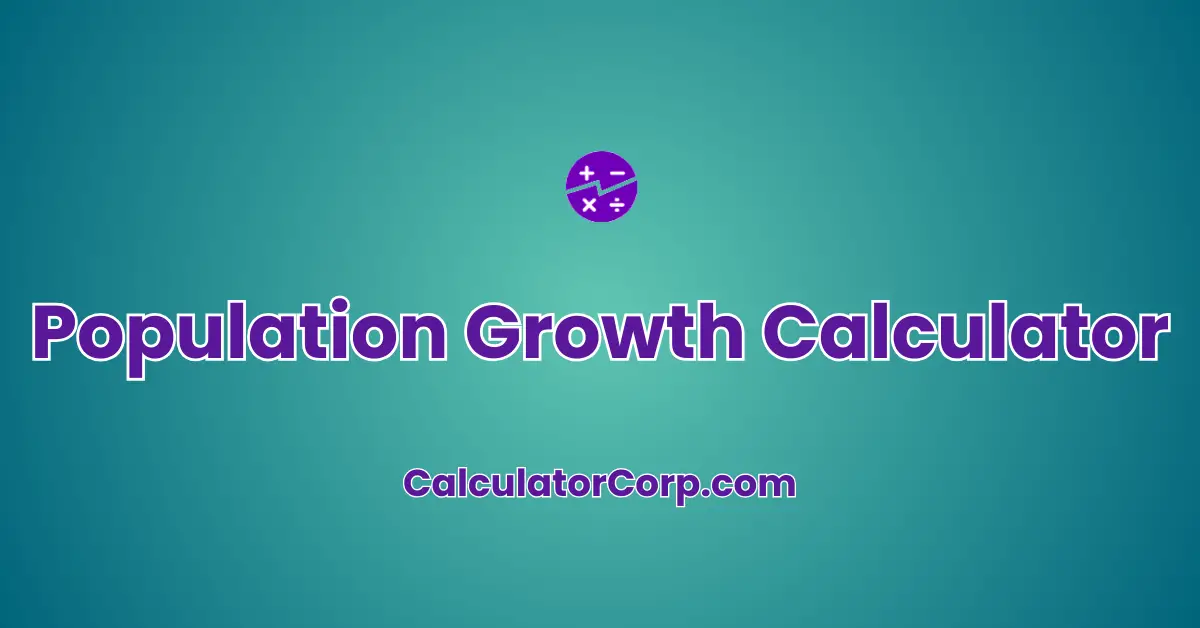The Population Growth Calculator is a highly useful and informative tool designed to estimate future population sizes based on current population data, growth rates, and the time span considered. This calculator simplifies complex demographic calculations into an easy-to-use format.
Population Growth Calculator – Project Future Population Instantly
Building this calc was hard work - we'd LOVE a coffee (or a beer - we're not picky :))!
By inputting the current population, the number of years into the future, and the annual growth rate, users can quickly determine the projected population size. This tool is especially valuable for understanding the implications of population dynamics on various aspects of society, including economics, resource management, and urban planning. For those interested in determining the percent growth given a final population figure, a dedicated Percent Growth Calculator is also available, ensuring comprehensive demographic analysis.
A Population Growth Calculator is an invaluable tool that helps demographers, researchers, and policymakers estimate future population sizes based on current data and growth rates. This tool simplifies complex calculations, providing insights into population trends and their potential impact on resources, infrastructure, and services.
How to Use the Population Growth Calculator
Using the Population Growth Calculator is straightforward and user-friendly. Follow these simple steps:
- Enter the Current Population: Input the current population number in the designated field. This is the starting population size.
- Specify the Number of Years: Enter the number of years into the future for which you want to calculate the population growth.
- Input the Annual Growth Rate: Provide the annual population growth rate in percentage. This rate should reflect the increase or decrease in population each year.
- Calculate: Click the ‘Calculate’ button to compute the future population based on the provided data.
- Reset, if Necessary: If you need to perform a new calculation or correct an error, use the ‘Reset’ button to clear all fields and start anew.
Explanation of the Population Growth Formula
The Population Growth Calculator uses a straightforward exponential growth formula, which is:

- Current Population: The population at the start of the period.
- Growth Rate: The annual percentage increase or decrease in the population.
- Number of Years: The time span over which the population grows.
This formula assumes a constant growth rate over the years and compounds the population accordingly.
Definition and Background of Population Growth
Population growth refers to the change in the number of individuals in a population over time. It is influenced by factors like birth rates, death rates, immigration, and emigration. Understanding population growth is crucial for planning and managing resources, healthcare, education, and infrastructure. It also plays a significant role in environmental and economic policies.
Step-by-Step Calculation Guide for Population Growth
- Determine the Current Population: This is your starting point. It can be the population of a city, country, or any defined group.
- Identify the Growth Rate: Usually expressed as a percentage, this rate can be found in demographic reports or estimated based on historical data.
- Choose a Time Span: Decide the number of years into the future for which you want to calculate the population.
- Use the Calculator: Input these values into the Population Growth Calculator to get your result.
Table of Example Calculations for Population Growth
| Current Population | Growth Rate (%) | Number of Years | Projected Population |
|---|---|---|---|
| 1,000,000 | 2 | 10 | 1,218,994.62 |
| 500,000 | 3 | 5 | 579,639.15 |
| 10,000 | 1 | 20 | 12,202.02 |
Glossary for Population Growth
- Demography: The study of populations, including size, growth, density, and distribution.
- Birth Rate: The number of births per year per 1,000 people in a population.
- Death Rate: The number of deaths per year per 1,000 people in a population.
- Immigration: The act of moving into a new country or region to live.
- Emigration: The act of leaving one’s country or region to live in another.
FAQ Section
Q: What is a good population growth rate? A: A “good” growth rate varies by context. It should support economic growth and sustainability without overburdening resources.
Q: Can population decrease in growth rate calculations? A: Yes, if the growth rate is negative, it indicates a declining population.
Q: How accurate are population growth predictions? A: They are estimates based on current trends. Changes in factors like birth rates or immigration policies can impact accuracy.
Q: Why is understanding population growth important? A: It helps in planning for future needs such as housing, education, healthcare, and infrastructure. It also has implications for environmental management and policy making.



